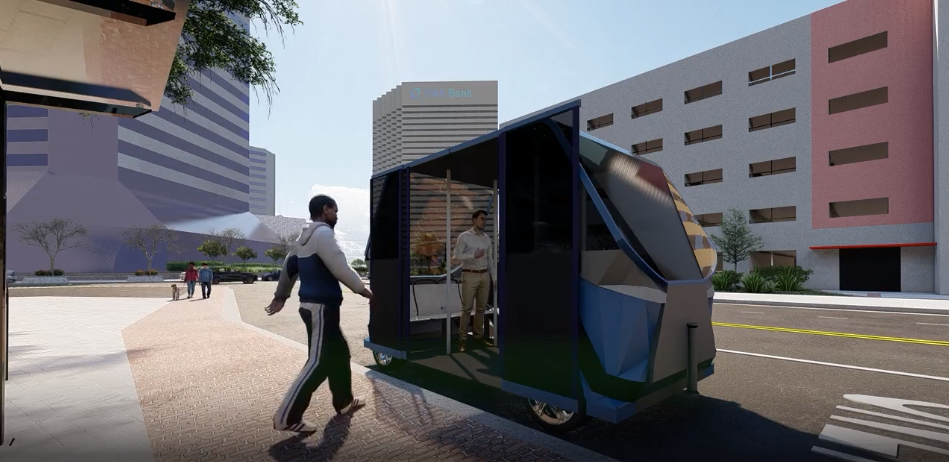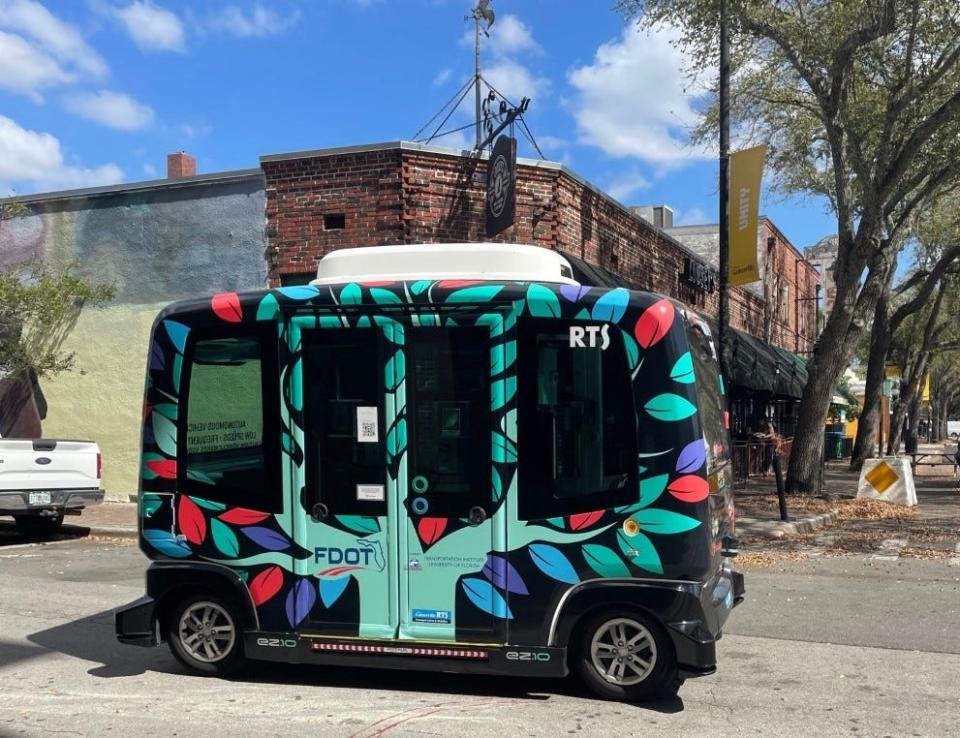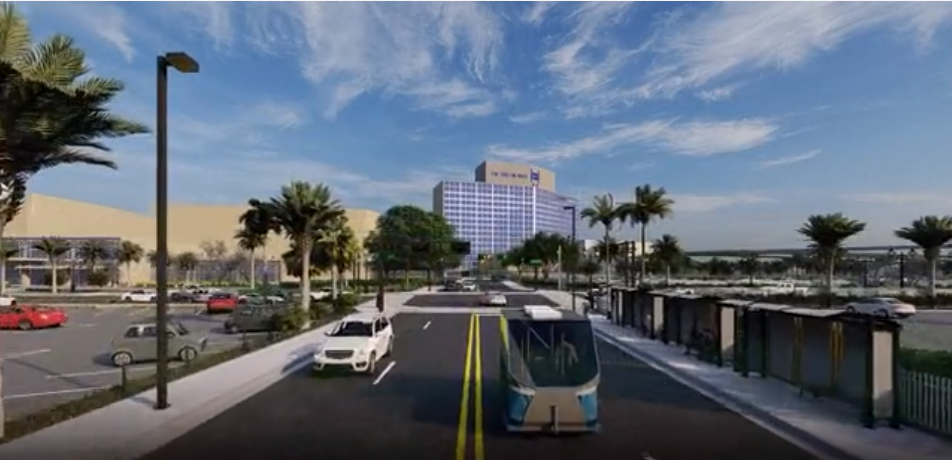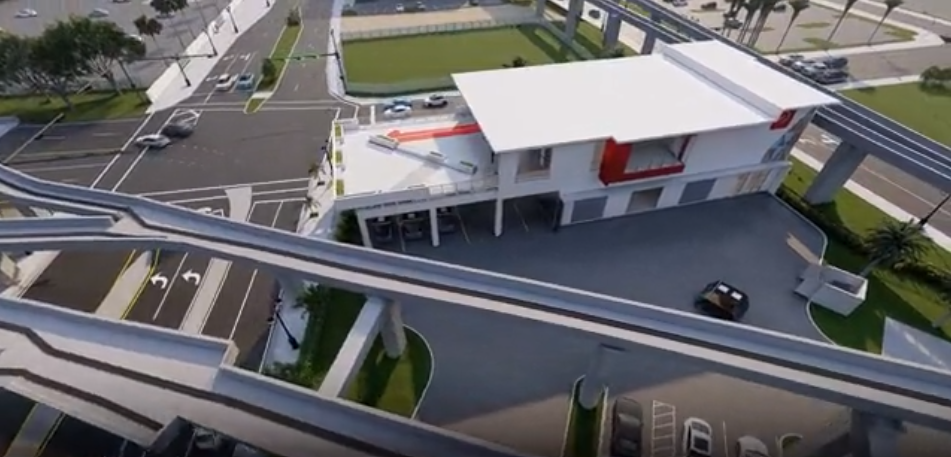Cost rises to $65 million for kick-off phase of "driverless" shuttles in Jacksonville

The cost of building a high-tech corridor for "driverless" shuttles on part of downtown Jacksonville's Bay Street went up to $65.6 million as the Jacksonville Transportation Authority gets ready for ground-breaking by the end of the year and the start of passenger service in mid-2025.
The latest all-in project cost for the Bay Street segment is an increase from the $49 million cap the JTA board approved in February 2022. The JTA board approved the higher budget Thursday after getting an update on the first phase of the planned Ultimate Urban Circulator —U2C for short — that will use sensors, cameras and computer programs to guide automated vehicles without needing a driver on board.
JTA has been testing and developing the technology since 2018 in what JTA CEO Nat Ford calls a "lighthouse project for the rest of the country" because other transit agencies are closely watching. But the move toward building the system has faced criticism that its technology has not advanced enough and the U2C will set back Jacksonville's mass transit system.
Gas tax money: Change in Jacksonville gas tax plan would shift $150 million from Skyway to Emerald Trail
Drive time: JTA moves closer to start of work on system of self-driving transit shuttles in downtown
Photo gallery: JTA and Guident host Inaugural National Autonomous Vehicle Day
City Council member Jimmy Peluso, who took office July 1 in a district that contains downtown, has said he's been a critic of the U2C concept for years and the "the time is ripe to finally put an end to it." He favors light rail or a streetcar line rather than the automated vehicles in the U2C.
Ford said the technology for automated vehicles is the wave of the future and offers far more flexibility for tailoring routes and service options than putting transit on tracks. He said the Federal Transit Administration has awarded about $200 million in competitive grants to JTA since 2016 because it will "finish what we started and fulfill our commitments."
"I see that enthusiasm bubble being burst if we're not very careful," board member Ari Jolly said.
Shuttles will run from downtown office district to sports complex
The Bay Street leg will run from an existing Skyway station in the office-tower district of downtown out to the sports complex and back. Unlike the Skyway trains that run on elevated guideways, the rubber-tired shuttles will operate at street-level. The plan is for the electric battery-powered vehicles to eventually travel above-ground, too, by replacing the Skyway trains.
The technology of automated vehicles is not new and other Florida cities have been doing test projects with mixed results. The city of Orlando approved $500,000 on a limited one-mile service that started in August on existing bus lanes.
Gainesville completed a test of such vehicles in 2022 on a route between the University of Florida and downtown where the shuttles operated in the same lanes as regular cars.
"For operational purposes, we're not there yet," Regional Transit System Director Jesus Gomez told the Gainesville Sun of the results. "There's a lot of things we'd need to change for it to become a regular transit option."
The Gainesville service generally got good reviews from riders, but motorists didn't like being behind slow-moving shuttles going 9 mph. Other drawbacks were heavy rain hindered the performance of the shuttles, and the sensors that guide them got confused by roadside objects or reflective materials.
"Even someone doing landscaping with a mower can stop the vehicle," Gomez said in March 2022.

Ford said it's an "apples to oranges" comparison between the vehicles used in pilot projects and the heightened specifications JTA will use for the U2C shuttles. For instance, he said the U2C shuttles will have multiple types of technology to guide them in varying conditions. He said they will operate just as well in heavy rain as in sunshine. The shuttles will travel at speeds between 15 mph and 25 mph.
Florida leads the country in seeing how autonomous shuttles can be part of transit systems, but in Florida and around the country, those are pilot projects that might last a few months or a year to collect data, said Greer Gillis, senior vice president and chief infrastructure and development officer for JTA.
The U2C will be built as a permanent fare-collecting service that falls under the Federal Transit Administration's oversight.
"They're going to hold us to the same standard running this operation with autonomous vehicles as they do with our fixed-route bus service," Gillis said. "That's why everyone is looking at us because when we make this work —and we will — all the other transit agencies will say, 'Okay, JTA wrote the playbook, we know how to put these into revenue service for ourselves.'"

The main reason for the latest increase in the cost of the first phase of the U2C down Bay Street is it will include building a new $9.4 operations and maintenance center for the system. JTA originally intended to use the existing Skyway operation center but needs to keep that operating for the Skyway so it can run while work occurs on the Bay Street corridor.
Federal deadline for starting U2C service is in two years
JTA is using a mix of local, state and federal dollars for the Bay Street leg. The U.S. Department of Transportation awarded a $25 million grant in 2019 for two projects: demolition of the Hart Bridge elevated ramp through the sports complex and the Bay Street Innovation Corridor with automated vehicles.
The city of Jacksonville completed the demolition of the elevated ramp and construction of a wider road. JTA faces a Sept. 30, 2025, deadline for using its $12.5 million share of the federal grant.
"We are on track for making that date and I will say our design-build partner team led by Balfour Beatty has committed to us that together, we're going to make that date," Gillis said.
Other funding for Bay Street includes $13 million from the state Department of Transportation. The bulk of the money is coming from JTA.
After that first phase, the conversion of the 2.5-mile elevated Skyway system to handle the rubber-tired vehicles will cost an estimated $247 million. JTA will use a chunk of money from a doubling of the local 6-cent per gallon gas tax to 12 cents for the Skyway part of the U2C.
Beyond downtown, the future expansion for the U2C is for extension into neighborhoods surrounding downtown by running the automated vehicles at street level. The overall network will have 10 miles of routes.

Downtown advocate Matt Brockelman said while there was some debate about the U2C when City Council approved using gas tax money for it in 2021, that shouldn't mean the "cake is baked" on building it if the technology and passenger capacity of the planned system hasn't advanced enough to make it successful.
"If we can get it to a place where it is going to be as effective as people originally wanted it to be, that's great," Brockelman said. "But if not, I hope they would be open-minded about looking for alternative solutions because at the end of the day, the outcomes are what we want, not necessarily one particular way of getting there."
"Made in America" requirement constrains vehicle choices
The model of automated vehicle most commonly associated with the U2C is shaped like a toaster with big windows for viewing and doors that open in the manner of an elevator for passengers. That might not be what's in place when the system starts, however, because the federal grant has a "Buy American" requirement and those kinds of vehicles are made abroad. The "plan B" is an American-made vehicle that looks more like an extended van that doesn't stand out more than any other vehicle in traffic.
Ford said JTA has been seeking a waiver from the made-in-America requirement and also is talking with global manufacturers about putting a vehicle plant in the United States to handle orders from JTA and other transit agencies.
Another factor affecting the Bay Street corridor will be whether the shuttles operate in mixed traffic or have their own dedicated lanes. JTA prefers the dedicated lanes but that would mean eliminating on-street parking along Bay Street to make room for the U2C lanes. Gillis said Bay Street would move all traffic more efficiently with dedicated lanes for the shuttles.
She said Bay Street willl be a "smart corridor" with intelligent transportation system technology for traffic signals, lighting and enhanced crosswalks. Eventually, the dedicated lanes for U2C shuttles could be used by other public transportation vehicles, bicycles and scooters.
Gillis said that before the construction groundbreaking, JTA will have a round of public outreach about what people can expect in downtown during the work.
"We also want to get their feedback one more time because we know this project has a lot of eyes on it," she said
This article originally appeared on Florida Times-Union: Automated shuttle transit corridor will cost more to build by 2025

